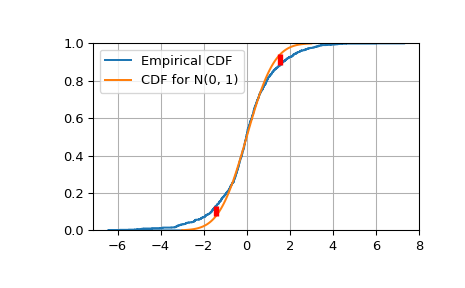scipy.special.kolmogorov#
- scipy.special.kolmogorov(y, out=None) = <ufunc 'kolmogorov'>#
Kolmogorov 分布的互补累积分布(生存函数)函数。
返回 Kolmogorov 极限分布的互补累积分布函数(当 n 趋于无穷大时,
D_n*\sqrt(n)),用于检验经验分布和理论分布之间是否相等。它等于(当 n->无穷大时的极限)概率,即sqrt(n) * max absolute deviation > y。- 参数:
- yfloat array_like
经验 CDF (ECDF) 和目标 CDF 之间的绝对偏差,乘以 sqrt(n)。
- outndarray, 可选
用于函数结果的可选输出数组
- 返回:
- 标量或 ndarray
kolmogorov(y) 的值
参见
kolmogi分布的反向生存函数
scipy.stats.kstwobign提供作为连续分布的功能
smirnov,smirnovi单侧分布的函数
注释
kolmogorov由 stats.kstest 用于 Kolmogorov-Smirnov 拟合优度检验的应用中。 出于历史原因,此函数在 scpy.special 中公开,但实现最准确的 CDF/SF/PDF/PPF/ISF 计算的推荐方法是使用 stats.kstwobign 分布。示例
显示至少与 0、0.5 和 1.0 一样大的间隙的概率。
>>> import numpy as np >>> from scipy.special import kolmogorov >>> from scipy.stats import kstwobign >>> kolmogorov([0, 0.5, 1.0]) array([ 1. , 0.96394524, 0.26999967])
将从 Laplace(0, 1) 分布中抽取的 1000 个样本与目标分布 Normal(0, 1) 分布进行比较。
>>> from scipy.stats import norm, laplace >>> rng = np.random.default_rng() >>> n = 1000 >>> lap01 = laplace(0, 1) >>> x = np.sort(lap01.rvs(n, random_state=rng)) >>> np.mean(x), np.std(x) (-0.05841730131499543, 1.3968109101997568)
构建经验 CDF 和 K-S 统计量 Dn。
>>> target = norm(0,1) # Normal mean 0, stddev 1 >>> cdfs = target.cdf(x) >>> ecdfs = np.arange(n+1, dtype=float)/n >>> gaps = np.column_stack([cdfs - ecdfs[:n], ecdfs[1:] - cdfs]) >>> Dn = np.max(gaps) >>> Kn = np.sqrt(n) * Dn >>> print('Dn=%f, sqrt(n)*Dn=%f' % (Dn, Kn)) Dn=0.043363, sqrt(n)*Dn=1.371265 >>> print(chr(10).join(['For a sample of size n drawn from a N(0, 1) distribution:', ... ' the approximate Kolmogorov probability that sqrt(n)*Dn>=%f is %f' % ... (Kn, kolmogorov(Kn)), ... ' the approximate Kolmogorov probability that sqrt(n)*Dn<=%f is %f' % ... (Kn, kstwobign.cdf(Kn))])) For a sample of size n drawn from a N(0, 1) distribution: the approximate Kolmogorov probability that sqrt(n)*Dn>=1.371265 is 0.046533 the approximate Kolmogorov probability that sqrt(n)*Dn<=1.371265 is 0.953467
绘制经验 CDF 与目标 N(0, 1) CDF 的对比图。
>>> import matplotlib.pyplot as plt >>> plt.step(np.concatenate([[-3], x]), ecdfs, where='post', label='Empirical CDF') >>> x3 = np.linspace(-3, 3, 100) >>> plt.plot(x3, target.cdf(x3), label='CDF for N(0, 1)') >>> plt.ylim([0, 1]); plt.grid(True); plt.legend(); >>> # Add vertical lines marking Dn+ and Dn- >>> iminus, iplus = np.argmax(gaps, axis=0) >>> plt.vlines([x[iminus]], ecdfs[iminus], cdfs[iminus], ... color='r', linestyle='dashed', lw=4) >>> plt.vlines([x[iplus]], cdfs[iplus], ecdfs[iplus+1], ... color='r', linestyle='dashed', lw=4) >>> plt.show()
